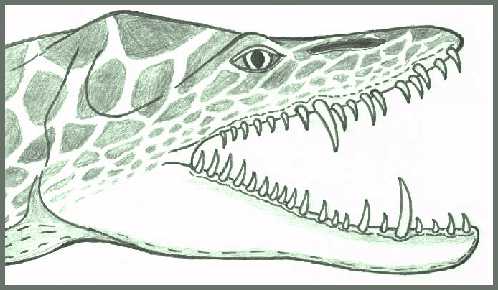Scott Mardis compares Lake Champlain and Loch Ness photographs with Plesiosaur skeletons above, and a view of a photograph of the head with the skull of a Plesiosaur at the British Museum.
Scott Mardis included this reconstruction of a type of Plesiosaur with a "back fin"-this would not ordinarily show up in fossils and a lower fleshy structure like this could have been more of a hump structure and serve the same purpose. Scott Mardis also suggested to me that there could be a natural tendency to develop two medial back humps above the front and rear limb girdles: the same possibility had occurred to me independently several years earlier, and others had also independently remarked upon it. The basic structures would be made up of skin over connective tissue, but you could also include a fatty layer in that, some kinds of sea creatures store fat in or near the fins.
Scott Mardis' overlay of a Champ sighting over a Plesiosaur skeleton and showing the known range of motion in the neck in that genus. I do not think the difference in the flexibility as stated by the witness was that severely different, and the main new feature to be present and not shown are the humps on the back. I prefer Heuvelman's description of the hump in Longnecks: "One big medial hump looking like two otr three smaller humps together", with underlying layers of fat underneath it, and the humps can change shape owing to turbulence waves in the wayter and from the action of muscular layers in it (Oudemans even suggested this last statement)
Below is a summary of sightings from Loch Morar, and the sightings are typically much like the composite profile that we get from the Longnecked reports at Loch Ness
(there is also a smaller residual of smaller shortnecked creatures in both locations)
Tim Dinsdale with his model he made illustrating his analysis of the "Monster" reports at Loch Ness. He had two different basic models, one with the two humps illustrated in his drawing in the book, and the three-humped version he shows in this model. He also said that it really did not matter since he thought the humps could change shape. Basically we are all saying the same thing on that point. Dinsdale thought the humps were showing subcutaneous air sacs but after some deliberation I opted for Heuvelmans' explanation as being safer.
Tim Dinsdale remarked that the body configuration of the creature in this sighting (seen partly on shore) was close to his composite model but made independently before his model was publicized. The drawing also "Predicted" the rhomboid fins that were not documented as belonging to the Loch Ness Monster until much later on.
























































